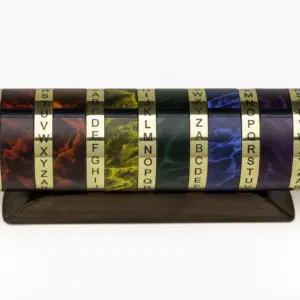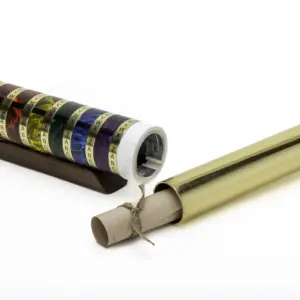Solving Puzzles is the Name of the Game
Justin Nevins had a problem.
The Seattle-based corporate consultant turned master artisan and maker of the first Cryptex® Security Box couldn’t get the digitally printed, marble-patterned polycarbonate laminate he uses for the most popular line of his hand-crafted puzzles to adhere to its substrate. After molding them into rings to wrap around the boxes, the laminates would bubble and peel away.
Adding to this challenge: Nevins would never know when the issue would arise. One batch of laminates would perform just fine but the next wouldn’t. What’s more, the company supplying the laminates was becoming less and less helpful in trying to solve the problem.
“The most important thing for me is to make the best product I can for customers,” Nevins says. “I spent 10 years and thousands of dollars looking for an answer but was at a point where I couldn’t market my product because of the inconsistency.”
The unpredictability was threatening his business at a crucial time: Nevins had been earning a world-wide reputation for offering exquisitely beautiful, superior quality security boxes for Escape Room games, treasure hunts and individual customers’ peace of mind.
Finally, as he was literally scraping the bottom of the barrel that he uses to store his supply of rings, he came across a screen-printing company half-way across the country in La Crosse, Wisc., and reached out to them in desperation.
“I took his call because the product looked cool,” remembers DuraTech Program Manager Pat Tully.
Through their initial discussion, Tully learned two critical things:
- The volume of product Nevin’s needed was well below the profitability threshold for DuraTech, a printer that typically produces millions of decorative labels and other parts for Fortune 500 companies.
- At the time (the year was 2018), DuraTech didn’t have a solution to Nevins’ particular problem.
“But we were curious. We wanted to learn more about this process of digital printing with in-mold decorating (IMD) or discover a hybrid process that could work [to solve Nevins’ issue],” Tully recalls.
The trial and error begin
“The first thing we tried was digitally printing parts with screen press white blocker ink, with and without a tie coat, or adhesion promoter, to bond the ink to the resin. It didn’t work that well,” Tully admits.
Over the ensuing months, Tully tried different substrate materials with different coatings, tweaking the tie coats and employing digital offset printing. None of it worked, either.
“We kept moving forward because we’re stubborn and wanted to succeed,” Tully chuckles.
Eventually, in 2021 – nearly three years into the project – a new material with a digital coating was introduced to market. In using it, Tully and his team saw much better adhesion, after the molding process, between the digital ink and the substrate; so he called Nevins, saying, ‘We can try this.’”
The next step was for Tully to make a trip to Washington to run samples with Nevins. Together, they spent two days doing trial press runs, using both digital and screen-printing processes.
“The difference in adhesion between the digitally printed rings and the screen-printed ones was like night and day,” Tully said. “You couldn’t remove the screen-printed rings from the boxes without using a tool. We had a winner.”
Now that they had landed on a successful printing process, taking the ink colors from Nevins’ original digitally printed rings and matching them to screen printing inks required more brainstorming and experimentation.
“We ended up printing the marble pattern with a half-tone black and then placing one of eight colors behind it,” Tully explained. “Simple and efficient.”
With that last piece of the puzzle solved, DuraTech printed 2,000 parts for Nevins’ Cryptex boxes – enough to supply him with months and months of worry-free production. “Once we got the press settings right, there were zero defects,” Nevins remembers. “I feel absolutely confident that, going forward, I’ll never have a problem with the laminates again. It’s just amazing.”
A win-win
“This was a hugely collaborative project,” Nevins notes. “But Pat just kept trying until we came to a solution. He bent over backward to solve my problem, and he’s flown out a couple of times to run parts with me. Who else would do that? No one!”
“DuraTech saved my business,” he declares.
“Once I made a commitment to help Justin, I didn’t want to strand him because he was running out of options,” Tully says. “I mean, he’s an entrepreneur with a really cool product. I didn’t want him to have to start all over with somebody else, so together we figured out.”
Moreover, “We were helpful to him, and he was helpful to us,” Tully concludes. “Justin got a stable product and DuraTech got data to better serve all our customers.”
Epilogue
Today, because of DuraTech’s knowledge and experience, we’ve become a leading provider of in-mold decorating (IMD) parts for manufacturers nation-wide. Click here to learn more.
As for Nevins, “This has been the first week in probably eight years that I don’t have any Cryptex manufacturing problems to solve,” he laughs. There are of course, orders to fill and ship around the world, but that’s okay. After all, “I’m doing what I love,” he says. “Every morning is like Christmas because I wake up excited, thinking, ‘I get to make Cryptexes today!’ That’s the secret to happiness.”

